斯大林格勒战役英文
- 格式:doc
- 大小:32.00 KB
- 文档页数:1

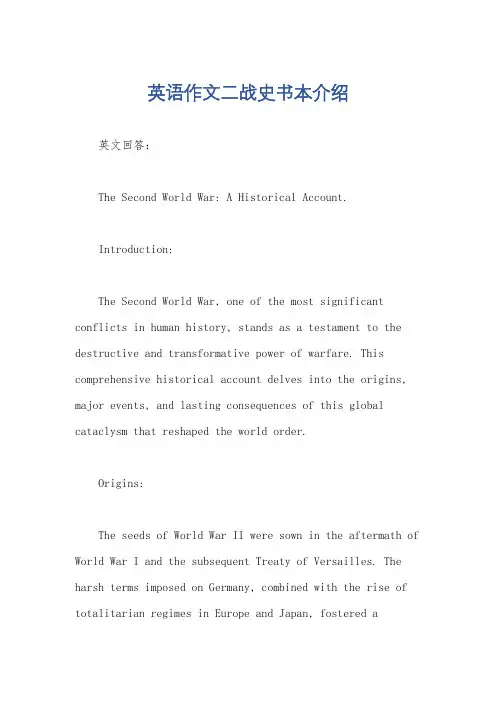
英语作文二战史书本介绍英文回答:The Second World War: A Historical Account.Introduction:The Second World War, one of the most significant conflicts in human history, stands as a testament to the destructive and transformative power of warfare. This comprehensive historical account delves into the origins, major events, and lasting consequences of this global cataclysm that reshaped the world order.Origins:The seeds of World War II were sown in the aftermath of World War I and the subsequent Treaty of Versailles. The harsh terms imposed on Germany, combined with the rise of totalitarian regimes in Europe and Japan, fostered aclimate of resentment and revanchism. The global economic depression of the 1930s further exacerbated tensions, laying the groundwork for the outbreak of hostilities.Major Events:With the invasion of Poland on September 1, 1939, World War II erupted. The conflict quickly escalated into a global war involving more than 100 countries. Key events included the Battle of Britain, the Axis invasion of the Soviet Union, the attack on Pearl Harbor, and the Allied D-Day landings in Normandy.Turning Points:The Battle of Stalingrad, fought from 1942 to 1943, marked a significant turning point in the war. The Soviet victory there weakened the German forces and began to shift the momentum in favor of the Allies. The D-Day landings in June 1944 opened a second front in Europe, furtherisolating Germany.Atomic Bombs and Surrender:By 1945, the Allies had gained the upper hand in the war. In an effort to force Japan to surrender, the United States dropped atomic bombs on the cities of Hiroshima and Nagasaki. The devastating toll of the atomic bombings hastened the Japanese surrender, ending the war on August 15, 1945.Consequences:World War II had a profound impact on the world. It resulted in an estimated 40-85 million casualties and significant destruction of infrastructure and cities. The war also led to the creation of the United Nations, the division of Germany, and the rise of the United States and the Soviet Union as superpowers.Conclusion:The Second World War remains a haunting reminder of the devastating consequences of conflict. Its origins, majorevents, and lasting consequences continue to be studied and analyzed by historians and scholars. This historical account has provided a comprehensive overview of this pivotal chapter in human history, shedding light on the complexities of war and its profound impact on the world.中文回答:第二次世界大战,历史记录。
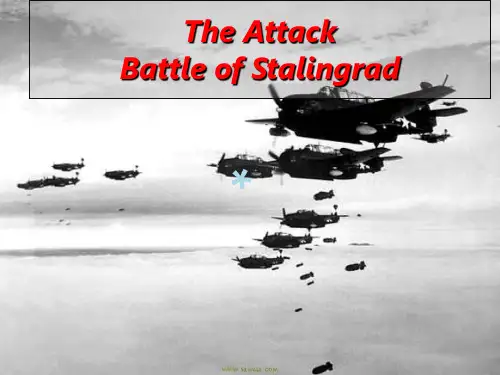
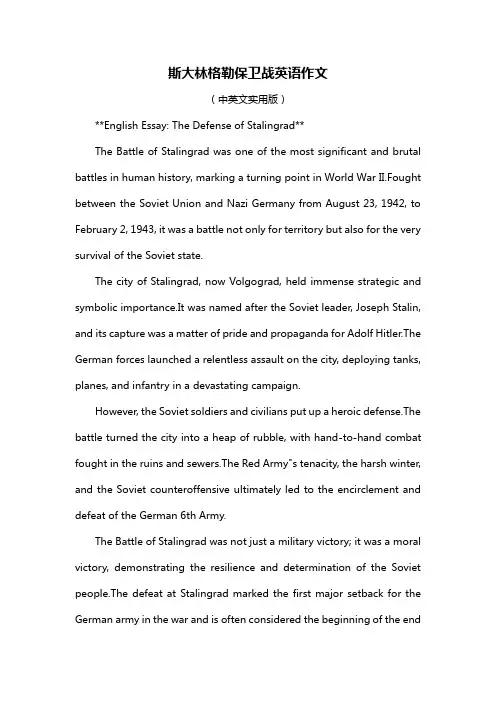
斯大林格勒保卫战英语作文(中英文实用版)**English Essay: The Defense of Stalingrad**The Battle of Stalingrad was one of the most significant and brutal battles in human history, marking a turning point in World War II.Fought between the Soviet Union and Nazi Germany from August 23, 1942, to February 2, 1943, it was a battle not only for territory but also for the very survival of the Soviet state.The city of Stalingrad, now Volgograd, held immense strategic and symbolic importance.It was named after the Soviet leader, Joseph Stalin, and its capture was a matter of pride and propaganda for Adolf Hitler.The German forces launched a relentless assault on the city, deploying tanks, planes, and infantry in a devastating campaign.However, the Soviet soldiers and civilians put up a heroic defense.The battle turned the city into a heap of rubble, with hand-to-hand combat fought in the ruins and sewers.The Red Army"s tenacity, the harsh winter, and the Soviet counteroffensive ultimately led to the encirclement and defeat of the German 6th Army.The Battle of Stalingrad was not just a military victory; it was a moral victory, demonstrating the resilience and determination of the Soviet people.The defeat at Stalingrad marked the first major setback for the German army in the war and is often considered the beginning of the endfor the Nazis.**斯大林格勒保卫战中文作文**斯大林格勒保卫战是人类历史上最为重大且残酷的战役之一,它成为了第二次世界大战的转折点。

斯大林格勒保卫战英语作文The Battle of Stalingrad was a pivotal moment during World War II, with the Soviet Union successfully defending the city against the German forces. 斯大林格勒保卫战是第二次世界大战期间的一个关键时刻,苏联成功地抵御了德军对这座城市的进攻。
The battle began on August 23, 1942, when German forces launched an all-out assault on the city of Stalingrad. 这场战役始于1942年8月23日,当时德军发动了对斯大林格勒的全面进攻。
For months, the city was under siege, with intense fighting taking place on the streets as both sides struggled for control. 数月来,这座城市处于围困之中,双方在街头激烈战斗,争夺控制权。
The brutal conditions of the battle took a heavy toll on both sides, with thousands of soldiers and civilians losing their lives in the fighting. 这场战斗的残酷条件对双方都造成了沉重的伤亡,成千上万的士兵和平民在战斗中丧生。
Despite the overwhelming odds against them, the Soviet forces were able to hold their ground and eventually force the German army to retreat. 尽管面对压倒性的劣势,苏联军队仍然能够坚守阵地,并最终迫使德军撤退。
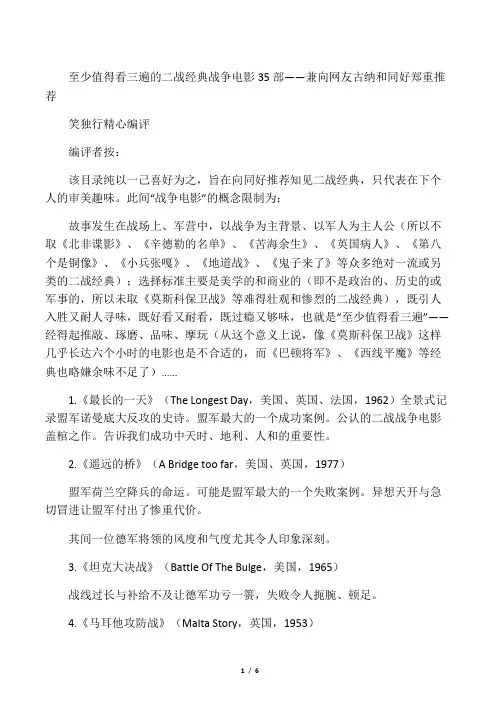
至少值得看三遍的二战经典战争电影35部——兼向网友古纳和同好郑重推荐笑独行精心编评编评者按:该目录纯以一己喜好为之,旨在向同好推荐知见二战经典,只代表在下个人的审美趣味。
此间“战争电影”的概念限制为:故事发生在战场上、军营中,以战争为主背景、以军人为主人公(所以不取《北非谍影》、《辛德勒的名单》、《苦海余生》、《英国病人》、《第八个是铜像》、《小兵张嘎》、《地道战》、《鬼子来了》等众多绝对一流或另类的二战经典);选择标准主要是美学的和商业的(即不是政治的、历史的或军事的,所以未取《莫斯科保卫战》等难得壮观和惨烈的二战经典),既引人入胜又耐人寻味,既好看又耐看,既过瘾又够味,也就是“至少值得看三遍”——经得起推敲、琢磨、品味、摩玩(从这个意义上说,像《莫斯科保卫战》这样几乎长达六个小时的电影也是不合适的,而《巴顿将军》、《西线平魔》等经典也略嫌余味不足了)……1.《最长的一天》(The Longest Day,美国、英国、法国,1962)全景式记录盟军诺曼底大反攻的史诗。
盟军最大的一个成功案例。
公认的二战战争电影盖棺之作。
告诉我们成功中天时、地利、人和的重要性。
2.《遥远的桥》(A Bridge too far,美国、英国,1977)盟军荷兰空降兵的命运。
可能是盟军最大的一个失败案例。
异想天开与急切冒进让盟军付出了惨重代价。
其间一位德军将领的风度和气度尤其令人印象深刻。
3.《坦克大决战》(Battle Of The Bulge,美国,1965)战线过长与补给不及让德军功亏一篑,失败令人扼腕、顿足。
4.《马耳他攻防战》(Malta Story,英国,1953)早期二战经典。
英军在马耳他捉襟见肘的遭遇。
5.《雷玛根大桥》(The Bridge at Remagen,法国,1969)情节紧凑,精彩纷呈,一气呵成,淋漓尽致。
6.《红一纵队》(The Big Red One,美国,1980)在残酷的战争面前,“活着”就是硬道理。
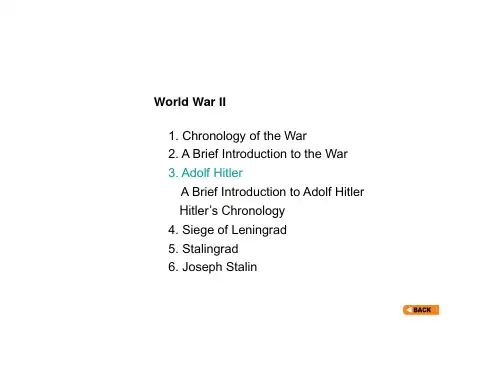

二战德国进攻苏联主要进程1、巴巴罗萨计划:1941年6月22日,德国人突然发动对苏联的进攻,计划代号为“巴巴罗萨”(Operation Barbarossa)。
无数苏联部队被包围并最终落入德国人的手中。
1941年12月5日德国人抵达莫斯科郊外并停止进军。
这一阶段主要为德军大规模进攻,苏军防御并后撤的过程,因为计划本身的漏洞以及苏军在后撤时采用了坚壁清野的战术,德军到达莫斯科时后勤已濒临极限。
June 22, 1941, the germans suddenly starts to Soviet offensive, plan code for "Barbarossa" (Operation Barbarossa). Countless Soviet troops surrounded and finally fall into the hands of the German people. On dec. 5, 1941 germans arrived in Moscow and stop march.This one phase mainly for the German offensive, the Soviet defence and retreat process, because the program itself and the loopholes in the Soviet retreat plunder and tactics, the germans arrived Moscow logistics has been on the verge of limit.2、列宁格勒保卫战:1941年8月下旬,德军投入32个步兵师、4个坦克师、4个摩托化师和1个骑兵旅的兵力,配备6000门大炮、4500门迫击炮和1000多架飞机,向列宁格勒发动猛烈攻势,扬言要在9月1日占领列宁格勒。

二战的历史事件第二次世界大战结束以后,德国和日本作为二战法西斯纳粹战败国,都受到了一定程度的惩罚。
但从当前社会现状来看今天店铺给大家精心挑选了二战的历史事件,希望文章对大家有所启发。
二战的历史事件一:莫斯科保卫战莫斯科保卫战(俄语:Битва под Москвой,德语:Schlacht um Moskau)又称莫斯科战役,是指第二次世界大战苏德战争中的一系列重要战略性战事的总称。
[1] 战事开始于1941年10月一直持续到1942年1月。
莫斯科保卫战包括苏军粉碎向莫斯科进攻的德军“中央”集团军群各突击集团而实施的一系列防御战役(1941年9月30日—12月5日)和进攻战役(1941年12月5日—1942年4月20日)。
此次战役最终以苏联红军的胜利而告终。
苏军取得了莫斯科战役的胜利,宣告了希特勒“闪电战战无不胜”的神话的破灭1941年6月22日,纳粹德国与其盟友入侵苏联,使苏联及苏联红军领导层大吃一惊。
德军以闪电战战术快速深入苏联领土。
装甲部队以钳形方式推进,先孤立然后彻底摧毁苏联红军。
德军北方集团军群向列宁格勒推进,南方集团军群则征服乌克兰和高加索高地,而中央集团军群则向莫斯科进发。
苏联红军的防线很快便崩溃,死伤枕藉。
1941年8月上旬,德军攻占斯摩棱斯克,是通往莫斯科路上一个重要据点,但斯摩棱斯克的战斗阻碍了德军的攻势直到9月中旬,有效地瓦解了闪电战的战术。
其后,古德里安的装甲部队到达莫斯科外围,但纳粹德国元首希特勒命令他转向南方去支持龙德施泰特指挥的南方集团军群对乌克兰首府基辅的攻击。
二战的历史事件二:斯大林格勒战役这是二次大战中,德国遭到史无前例的惨败一役,影片在描写战剧照役的同时,企图探讨两个受害人因战争改变命运的经过。
1942年深秋,一列往苏联驶去的列车上,两名德国士兵汉斯及洛奴打赌谁可以保住生命,经过多场战斗的摧残,他们竟然……本片由电视剧压缩而成,市面上流传的版本或长或短。
影片从德军将领汉斯和一群德国士兵的角度,描写攻打斯大林格勒这一场二战中最惨烈的战役。
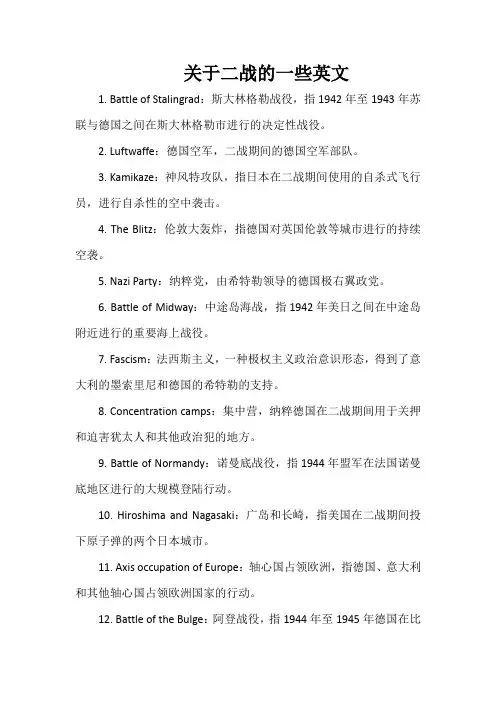
关于二战的一些英文1. Battle of Stalingrad:斯大林格勒战役,指1942年至1943年苏联与德国之间在斯大林格勒市进行的决定性战役。
2. Luftwaffe:德国空军,二战期间的德国空军部队。
3. Kamikaze:神风特攻队,指日本在二战期间使用的自杀式飞行员,进行自杀性的空中袭击。
4. The Blitz:伦敦大轰炸,指德国对英国伦敦等城市进行的持续空袭。
5. Nazi Party:纳粹党,由希特勒领导的德国极右翼政党。
6. Battle of Midway:中途岛海战,指1942年美日之间在中途岛附近进行的重要海上战役。
7. Fascism:法西斯主义,一种极权主义政治意识形态,得到了意大利的墨索里尼和德国的希特勒的支持。
8. Concentration camps:集中营,纳粹德国在二战期间用于关押和迫害犹太人和其他政治犯的地方。
9. Battle of Normandy:诺曼底战役,指1944年盟军在法国诺曼底地区进行的大规模登陆行动。
10. Hiroshima and Nagasaki:广岛和长崎,指美国在二战期间投下原子弹的两个日本城市。
11. Axis occupation of Europe:轴心国占领欧洲,指德国、意大利和其他轴心国占领欧洲国家的行动。
12. Battle of the Bulge:阿登战役,指1944年至1945年德国在比利时阿登地区对盟军发起的最后一次大规模反攻。
13. Eastern Front:东线战场,指二战期间德国与苏联之间的战线。
14. Victory in Europe Day (V-E Day):欧洲胜利日,指1945年盟军正式宣布欧洲战争结束的日期。
15. Propaganda:宣传,指在战争期间使用各种媒体手段传播特定政治观点和信息的活动。
16. Resistance movements:抵抗运动,指在被占领国家中组织的反抗轴心国统治的地下组织和行动。
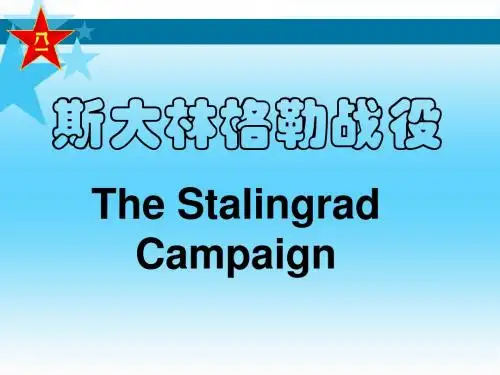
斯大林格勒战役英文The Battle of StalingradThe Battle of Stalingrad (23 August 1942 – 2 February 1943) was a major battle of World War II inwhich Nazi Germany and its allies fought the Soviet Union for control of the city of Stalingrad (now Volgograd)in the south-western Soviet Union. Marked by constant close quarters combat and direct assaults on civilians by air raids, it is the single largest and bloodiest battle in the history of warfare. The heavy losses inflicted on the Wehrmacht make it arguably the most strategically decisive battle of the whole war.[12] It was a turning point in the European theatre of World War II–the German forces never regained the initiative inthe East and withdrew a vast military force from the West to replace their losses.The German offensive to capture Stalingrad began in late summer 1942 using the 6th Army and elements of the 4th Panzer Army. The attack was supported by intensive Luftwaffe bombing that reduced much of the city to rubble. The fighting degenerated into building-to-building fighting, and both sides poured reinforcements into the city. By mid-November 1942, the Germans had pushed the Soviet defenders back at great cost into narrow zones generally along the west bank of the Volga River.On 19 November 1942, the Red Army launched Operation Uranus, a two-pronged attack targeting the weaker Romanianand Hungarian forces protecting the German 6th Army's flanks.[13] The Axis forces on the flanks were overrun and the 6th Army was cut off and surrounded in the Stalingrad area. Adolf Hitler ordered that the army stay in Stalingrad and makeno attempt to break out; instead, attempts were made to supply the army by air and to break the encirclement from the outside. Heavy fighting continued for another two months. By the beginning of February 1943, the Axis forces in Stalingrad had exhausted their ammunition and food. The remaining elements of the 6th Army surrendered. The battle lasted five months, one week, and three days.。
The Battle of Stalingrad: A Defining Momentin World War IIThe Battle of Stalingrad, one of the most crucial and devastating conflicts in human history, serves as a testament to the resilience and determination of the human spirit in the face of overwhelming adversity. This titanic struggle, fought between August 23, 1942, and February 2, 1943, was not merely a battle for a city; it was a battle for the soul of Europe and the direction of World War II. Stalingrad, named after Soviet leader Joseph Stalin, was not just a strategically important industrial center but also held immense symbolic value. For Adolf Hitler, capturing the city was a matter of prestige and anessential step towards his ambition of controlling the entire continent. The German army, confident after a string of victories, marched into Stalingrad with the expectation of a quick triumph. However, they were met with a tenacious resistance from the Soviet soldiers and civilians alike, who were determined to defend their land at any cost.The battle was marked by extreme brutality and suffering. Both sides endured unimaginable hardships, withsoldiers fighting in the ruins of the city amidst the freezing cold of a Russian winter. Civilians, trapped inthe crossfire, suffered immensely from hunger, disease, and constant bombardment. The battle became a war of attrition, with each side refusing to yield, resulting in a brutal urban warfare that left the city in ruins.One of the turning points of the battle was Operation Uranus, a daring Soviet counter-offensive that encircledthe German Sixth Army. Despite being vastly outnumbered and outgunned, the Soviet forces demonstrated exceptionaltactical brilliance, exploiting the weaknesses in the German flanks. This move not only trapped hundreds of thousands of German soldiers but also dealt a severe blowto the once-unstoppable Wehrmacht's morale.The Battle of Stalingrad had far-reaching consequences. It marked the first major defeat of Nazi Germany on the Eastern Front, halting their eastward advance and shifting the tide of the war. The victory boosted Soviet morale and reinforced their belief in ultimate triumph. For the restof the world, it shattered the myth of German invincibility, bolstering the resolve of other Allied nations.Moreover, the battle served as a microcosm of thelarger conflict, exposing the horrors of war and the human cost of aggression. The estimated two million casualties, including both military and civilian, make it one of the bloodiest battles in history. It was a testament to the destructive capacity of modern warfare and the resilience of those who resist oppression.In conclusion, the Battle of Stalingrad was more than a military engagement; it was a crucible of courage, sacrifice, and the indomitable will to survive. Its legacy resonates to this day, reminding us of the devastation of war and the importance of peace. As we reflect on this historic event, let us remember the lessons it teaches –the power of unity in adversity, the resilience of the human spirit, and the enduring significance of defending freedom against tyranny.The Battle of Stalingrad stands as a grim reminder of the past, a beacon of hope for the future, and an irrefutable testament to the strength of the human spiritin the face of adversity. In the annals of history, it remains a defining moment in World War II, a symbol ofresistance, and a testament to the unyielding spirit of those who fought for their home, their freedom, and their future.。
战争中有哪些奇迹英文作文英文:There have been many miracles in wars throughout history. These miracles can come in many forms, from incredible acts of bravery to unexpected victories against all odds. One of the most famous examples of a war miracle is the Battle of Dunkirk during World War II. The British forces were completely surrounded by German troops, and it seemed like there was no hope for escape. However, aflotilla of civilian boats came to their rescue and helped evacuate over 300,000 soldiers to safety. This unexpected turn of events was truly a miracle, and it helped boost morale for the Allied forces.Another example of a war miracle is the Battle of Stalingrad during World War II. The German army was advancing on the city, and it seemed like they would be able to take it easily. However, the Soviet Union was able to hold them off and eventually push them back, despitebeing outnumbered and outgunned. This victory was a miracle, as it helped turn the tide of the war in favor of the Allies.There are many other examples of war miraclesthroughout history, from the Battle of Thermopylae to the Siege of Vienna. These events remind us that even in the darkest of times, there is always hope for a miracle.中文:历史上有许多战争中的奇迹。
斯大林格勒电影英文作文The film "Enemy at the Gates" is a historical drama set during the Battle of Stalingrad in World War II. It tells the story of Vassili Zaitsev, a young Soviet sniper who becomes a national hero for his exceptional marksmanship. The film explores themes of war, survival, love, and propaganda against the backdrop of one of the most brutal battles in human history. The film effectively portrays the sheer scale and devastation of the Battle of Stalingrad. The bombed-out ruins of the city become a claustrophobic battleground where every street corner and building is a potential death trap. The audience is constantly reminded of the fragility of life as soldiers are mowed down by enemy fire or succumb to the harsh winter conditions. The film does not shy away from depicting the brutality of war, with graphic scenes of violence and death that highlight the human cost of conflict. Vassili Zaitsev is portrayed as a reluctant hero who is thrust into the spotlight by the Soviet propaganda machine. He is a skilled marksman, but he is also deeply affected by the horrors he witnesses. The film explores his internal conflict as he struggles to reconcile his duty to his country with his own desire for survival and his love for Tania, a fellow soldier. Jude Law delivers a nuanced performance, capturing both Vassili's determination and his vulnerability. The film also explores the theme of propaganda and its role in shaping public perception of war. The Soviet government uses Vassili's story to boost morale and inspire the people to fight for their country. Danilov, a political officer, is tasked with creating a legend around Vassili, turning him into a symbol of Soviet resistance. The film raises questions about the ethics of propaganda and the way in which truth can be manipulated for political gain. The relationship between Vassili and Tania adds a layer of emotional complexity to the film. Their love story provides a glimmer of hope amidst the despair and destruction of war. Rachel Weisz delivers a powerful performance as Tania, a strong and resilient woman who is fighting for her own survival. The scenes between Vassili and Tania offer a brief respite from the horrors of war and remind the audience of the human connections that can endure even in the darkest of times. The film also features a compelling antagonist in the form of Major K?nig, a German sniper who is sent to Stalingrad to eliminate Vassili. K?nig is portrayed as a skilled and ruthlessopponent who represents the Nazi war machine. The cat-and-mouse game between Vassili and K?nig adds a layer of suspense to the film and highlights the psychological toll that war takes on both sides. Ed Harris delivers a chilling performance as K?nig, capturing the character's cold and calculating nature. "Enemy at the Gates" is a powerful and moving film that offers a glimpse into the horrors of war and the resilience of the human spirit. It is a story of survival, love, and the power of propaganda. The film's stunning visuals, compelling characters, and thought-provoking themes make it a memorable cinematic experience. However, it is important to note that the film has been criticized for historical inaccuracies and its portrayal of certain events. While it offers a compelling narrative, it is essential to approach it with a critical perspective and seek out additional sources for a more comprehensive understanding of the Battle of Stalingrad.。
二战欧洲战场十大战役1.幻影突击――波兰闪击战名称:波兰战役地点:波兰参战方:德国、斯洛伐克和苏联对阵波兰结果:德国胜利、二战爆发参战方兵力:德国151万人、波兰100万人伤亡情况:德军伤亡4万多人、波军伤亡20万人主要指挥官:布劳希奇、伦德施泰特1939年9月1日4:40,德军联合其附庸国斯洛伐克的军队入侵波兰。
英国和法国给予纳粹德国48小时限期撤出波兰领土。
因为德国没有听从英法的警告,英国和法国在1939年9月3日向德国宣战。
所有参与的国家都没有估计到这场战争会超过第一次世界大战的规模。
前苏联根据《苏德互不侵犯条约》的秘密条款以及对于之前1921年签订的屈辱的《里加和约》的不满,在1939年9月17日从东面收复寇松线以西的西乌克兰与西白俄罗斯。
德军和红军在9月28日在布格河会师。
波兰侵略战大致上在10月6日结束,但是波兰没有向德国或苏联投降。
而且,波兰的流亡政府在盟国组织了一个有力的地下组织。
2.悲情马奇诺――法兰西会战名称:法兰西会战时间:1940年5-6月参战方:德军、法国、英国伤亡情况:德军亡2.7万余人,法军亡8.4万人,英军损失6.8万人法兰西会战是二战中德军为侵占法国、荷兰、比利时和卢森堡,于1940年5-6月采取的军事行动。
1940年5月10日,德军发起进攻,对法、比、荷境内的72个机场及纵深目标实施航空突击,并在鹿特丹、海牙实施空降。
在德B集团军群右翼,荷军在德军打击下迅速瓦解,于15日投降;在其左翼,德空降兵于10日凌晨偷袭扼守列日的埃本埃马尔要塞成功,比军防御即告崩溃。
6月5日,德B集团军群突破法军沿索姆河和埃纳河仓促构筑的“魏刚防线”,直逼巴黎。
10日,法政府迁至图尔。
同日,意大利对法、英宣战。
14日,德军占领巴黎。
16日,H.P.贝当接任法国总理。
17日,德军从侧后推进至瑞士边界,法第2、第3集团军群被围。
同日,法政府请求停战,22日与德国签订《贡比涅停战协定》,同意德国占领法国北部和大西洋沿岸地区,而法国失去了约2/3的国土,并宣布退出战争和解除法国舰队武装。
朱可夫读后感英文回答:Comprehension of Marshal Zhukov's Memoir:Marshal Georgy Zhukov's memoir, "Reminiscences and Reflections," is a captivating and illuminating account of his life and experiences as a military commander during World War II. Zhukov's writings offer a unique and invaluable perspective on the events of the war, as well as his own reflections on leadership, strategy, and the nature of conflict.Zhukov's memoir is notable for its candor and self-reflection. He does not shy away from acknowledging his mistakes or criticizing others, even those who were his superiors. This honesty lends credibility to his account and provides readers with a more nuanced understanding of the complexities of war.One of the most striking aspects of Zhukov's memoir is his emphasis on the importance of leadership. He believed that a successful military commander must possess a combination of strategic brilliance, tactical flexibility, and the ability to inspire and motivate his troops.Zhukov's own leadership style was characterized by a relentless pursuit of victory, a willingness to take risks, and a deep concern for the welfare of his soldiers.Zhukov's account of the key battles of World War II, such as the Battle of Stalingrad and the Battle of Berlin, is both vivid and insightful. He provides detailed descriptions of the strategic decision-making, the challenges faced by his troops, and the personal experiences of those involved. Through these accounts, readers gain a deeper appreciation for the complexities of military operations and the human cost of war.In addition to his insights into military strategy, Zhukov's memoir also offers valuable lessons on the nature of conflict and the challenges of peacemaking. He argues that war should only be used as a last resort and that itis essential to strive for diplomatic solutions whenever possible. Zhukov also warns against the dangers of complacency and the importance of maintaining a strong defense even during times of peace.Overall, Marshal Georgy Zhukov's memoir is a must-read for anyone interested in World War II, military history, or the study of leadership. Its candid and insightful accountof one of the war's most prominent figures provides invaluable lessons on the complexities of conflict, the nature of leadership, and the challenges of peacemaking.中文回答:拜读朱可夫元帅的《回忆与思考》,让我深受启发,受益匪浅。
The Battle of Stalingrad
The Battle of Stalingrad (23 August 1942 – 2 February 1943) was a major battle of World War II in
which Nazi Germany and its allies fought the Soviet Union for control of the city of Stalingrad (now Volgograd)in the south-western Soviet Union. Marked by constant close quarters combat and direct assaults on civilians by air raids, it is the single largest and bloodiest battle in the history of warfare. The heavy losses inflicted on the Wehrmacht make it arguably the most strategically decisive battle of the whole war.[12] It was a turning point in the European theatre of World War II–the German forces never regained the initiative in
the East and withdrew a vast military force from the West to replace their losses.
The German offensive to capture Stalingrad began in late summer 1942 using the 6th Army and elements of the 4th Panzer Army. The attack was supported by intensive Luftwaffe bombing that reduced much of the city to rubble. The fighting degenerated into building-to-building fighting, and both sides poured reinforcements into the city. By mid-November 1942, the Germans had pushed the Soviet defenders back at great cost into narrow zones generally along the west bank of the Volga River.
On 19 November 1942, the Red Army launched Operation Uranus, a two-pronged attack targeting the weaker Romanianand Hungarian forces protecting the German 6th Army's flanks.[13] The Axis forces on the flanks were overrun and the 6th Army was cut off and surrounded in the Stalingrad area. Adolf Hitler ordered that the army stay in Stalingrad and make no attempt to break out; instead, attempts were made to supply the army by air and to break the encirclement from the outside. Heavy fighting continued for another two months. By the beginning of February 1943, the Axis forces in Stalingrad had exhausted their ammunition and food. The remaining elements of the 6th Army surrendered. The battle lasted five months, one week, and three days.。